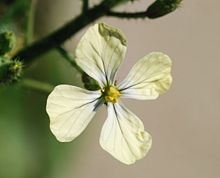 |
|
|
|
|
| Cuisines | Herbal | Spice | Curry | Yeast | Recipe | ||||||
|
Arugula Eruca sativa (syn. E. vesicaria subsp. sativa (Miller) Thell., Brassica eruca L.), is an edible annual plant, commonly known as rocket, roquette, rucola, rugula, or arugula, not to be confused with Wild rocket. It is a species of Eruca native to the Mediterranean region, from Morocco and Portugal in the west to Lebanon and Turkey in the east. It is closely related to Eruca vesicaria and included by some botanists in that either as a subspecies E. vesicaria subsp. sativa or not distinguished at all; it can be distinguished from E. vesicaria by its early deciduous sepals. It is an annual plant growing 20–100 centimetres (8–39 in) in height. The leaves are deeply pinnately lobed with four to ten small lateral lobes and a large terminal lobe. The flowers are 2–4 cm (0.8–1.6 in) in diameter, arranged in a corymb, with the typical Brassicaceae flower structure; the petals are creamy white with purple veins, and the stamens yellow; the sepals are shed soon after the flower opens. The fruit is a siliqua (pod) 12–35 millimetres (0.5–1.4 in) long with an apical beak, and containing several seeds (which are edible). The species has a chromosome number of 2n = 22. Vernacular names include garden rocket or simply rocket (British, Australian, Canadian and New Zealand English), eruca, rocket salad, and arugula (American English). All names ultimately derive from the Latin word eruca, a name for an unspecified plant in the family Brassicaceae, probably a type of cabbage. Cultivation and uses It is used as a leaf vegetable, which looks like a longer leaved and open lettuce. It is rich in vitamin C and potassium. It is frequently cultivated, although domestication cannot be considered complete. It has been grown in the Mediterranean area since Roman times, and is considered an aphrodisiac. Before the 1990s it was usually collected in the wild and was not cultivated on a large scale or researched scientifically. In addition to the leaves, the flowers (often used in salads as an edible garnish), young seed pods and mature seeds are all edible. It is now cultivated in various places, especially in Veneto, Italy, but is available throughout the world. It is also locally naturalised away from its native range in temperate regions around the world, including northern Europe and North America. In India, the mature seeds are known as Gargeer. It has a rich, peppery taste, and has an exceptionally strong flavour for a leafy green. It is generally used in salads, often mixed with other greens in a mesclun, but is also cooked as a vegetable or used raw with pasta or meats in northern Italy and in western Slovenia (especially in the Slovenian Istria). In Italy, rocket is often used in pizzas, added just before the baking period ends or immediately afterwards, so that it will not wilt in the heat. In the Slovenian Littoral, it is often combined with boiled potatoes, also as a soup. In the later periods, it is frequently served together with cheese burek, especially in the town of Koper. On the island of Ischia in the Gulf of Naples, a digestive alcohol called rucolino is made from the plant, a drink often enjoyed in small quantities following a meal. The liquor is a local specialty enjoyed in the same way as a limoncello or grappa and has a sweet peppery taste that washes down easily. In Brazil, its use is widespread. Arugula is eaten raw in salads with dressing. A popular combination is arugula mixed with Mozzarella cheese (normally made out of buffalo dairy) and sun-dried tomato. In Egypt the plant is commonly eaten with ful medames for breakfast, and regularly accompanies local seafood dishes. In West Asia and Northern India, arugula seeds are pressed to make taramira oil, used in pickling and (after aging to remove acridity) as a salad or cooking oil. The seed cake is also used as animal feed. In Persian cuisine Fenugreek leaves are used and called شنبلیله (shanbalile). It is the key ingredient and one of several greens incorporated into ghormeh sabzi, often said to be the Iranian national dish. Fenugreek is used in Eritrean and Ethiopian cuisine. The word for fenugreek in Amharic is abesh (or abish), and the seed is used in Ethiopia as a natural herbal medicine in the treatment of diabetes. Yemenite Jews following the interpretation of Rabbi Salomon Isaacides, Rashi of Talmūd, believe fenugreek, which they call hilbeh, hilba, helba, or halba (חילבה) is the Talmudic Rubia (רוביא). They use fenugreek to produce a sauce also called hilbeh, reminiscent of curry. It is consumed daily but ceremoniously during the meal of the first and/or second night of Rosh Hashana (Jewish New Year). MedicinalA June 2011 study at the Australian Centre for Integrative Clinical and Molecular Medicine found that men aged 25 to 52 who took a fenugreek extract twice daily for six weeks scored 25% higher on tests gauging libido levels than those who took a placebo. LactationFenugreek seeds are thought to be a galactagogue that is often used to increase milk supply in lactating women. |











